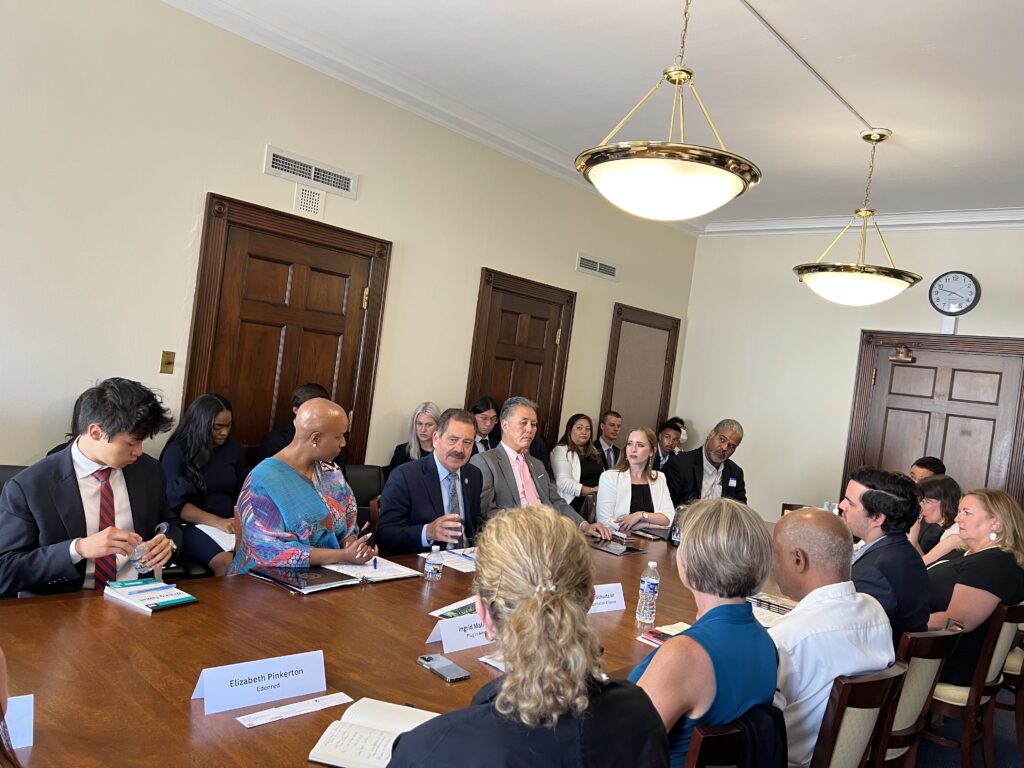
Setting priorities at Future of Transportation Caucus Roundtable

With federal transportation funding set to be reauthorized in three years, the congressional Future of Transportation Caucus met with advocates to discuss the country’s most pressing funding priorities.

A crucial conversation about our transportation priorities
With every passing day, reauthorization for federal surface transportation funding grows closer and closer. Our current framework, the Infrastructure Investment and Jobs Act (IIJA), expires in 2026, and it’s critical that the country gets its funding priorities right by then. If our dollars don’t go towards the right initiatives and objectives, spending more money on transportation and infrastructure will only result in the same poor outcomes. With many competing priorities, discussion between policymakers and advocates about the current state—and future of—our national transportation system remains essential.
Last Wednesday, July 12th, the Future of Transportation Caucus, led by Representatives Ayanna Pressley (MA-07), Jesús “Chuy” García (IL-04), and Mark Takano (CA-39), led a roundtable discussion with advocates on transportation electrification, public transit, active transportation, public health, and road safety. These leaders met to talk through transportation priorities and find common ground.
What does our transportation funding need to focus on?
Advocates covered a wide range of issues, including transportation electrification, operations funding for public transit, and road safety. Advocates discussed the need to electrify public transit and medium/heavy-duty vehicles as well as affordable, safe, and equitable charging for electric vehicles (EVs). Regarding operations funding, advocates spoke about expanding and supporting operations in the face of transit fiscal cliffs, increasing service frequency, and exploring solutions to reduce barriers and increase transit ridership. Finally, road safety advocates discussed improvements for bicyclist and pedestrian safety as well as the dangers of poorly thought-out autonomous vehicle (AV) rollouts in cities.
One point in particular proved to be an underlying thread throughout the conversation: a need for the basics—the baseline infrastructure essential for cities—to be focused on people, at the very minimum. Advocates emphasized the importance of good bus systems and facilities, functional sidewalks, and more, recounting how much of a difference that investing in these essentials made in their communities and socioeconomic outcomes.
Looking ahead to the 2026 reauthorization
It’s essential that Congress gets the right transportation funding priorities in line before the next reauthorization cycle rolls around in 2026. With a massive rise in pedestrian fatalities, a focus on expansion that leaves , and a climate crisis that has only begun, America can’t afford to continue with more of the same. Instead, we need to rethink what our current funding dollars are going towards. T4A’s three key principles for transportation infrastructure investment—prioritize maintenance, design for safety over speed, and connect people to jobs and services—can serve as a guiding framework for a plan that brings the country towards safe, convenient, affordable transportation for all.
We need to move past the outdated “80/20” highway/transit funding split and resist getting distracted by fantasies that promote car dependence like smart cities dominated by AVs. Rather, our federal funding needs to prioritize the maintenance and repair of existing infrastructure, advance safer streetscapes centered on people first, and prioritize access to goods and services, including increasing operations funding for public transit so agencies can expand the crucial services that people rely on.
At the end of the day, we need to commit to investing in our vision of an accessible and equitable transportation system that strengthens communities—one that focuses on moving people, not just vehicles.



